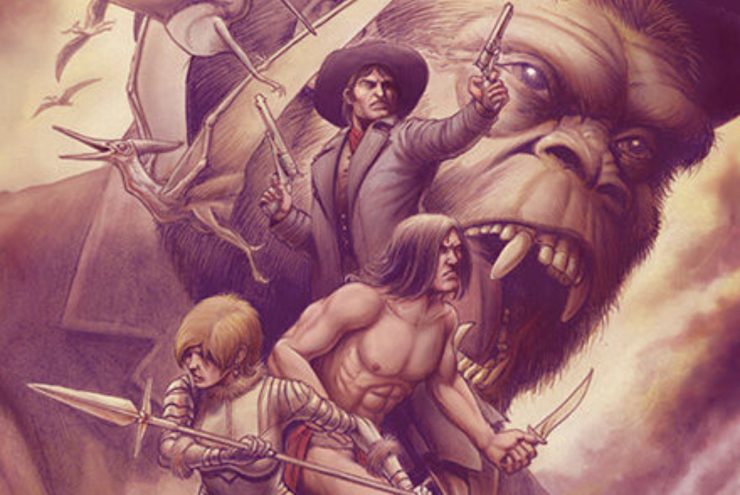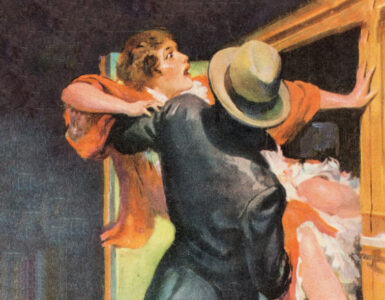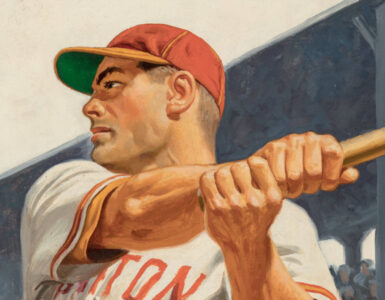Pulp magazines have influenced writers, artists, film directors, software developers, and countless others over the years. Our “PulpFest Profiles” focus on contemporary creators who have drawn inspiration from these rough-paper fiction magazines.
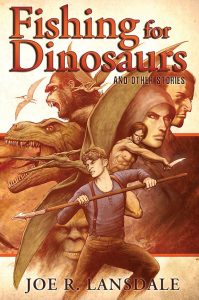 He’s been called the Bard of East Texas, the best-selling cult author of all time, and the Popcorn King. At his core, Joe R. Lansdale is simply a storyteller in love with stories.
He’s been called the Bard of East Texas, the best-selling cult author of all time, and the Popcorn King. At his core, Joe R. Lansdale is simply a storyteller in love with stories.
Since the age of four, Joe has been reading anything he could get his hands on. It was only a matter of time before he began mixing in his own life experiences and filtering everything through his incredible imagination to create hundreds of stories, novels, and poems.
Lansdale writes in whatever genre inspires him at the time. He earned his reputation as a “champion mojo storyteller” by penning westerns, horror, science fiction, mystery, suspense, “retro” pulp tales, and more. His 2020 biography notes that he “has written 50 novels and published more than 30 short story collections … along with many chapbooks and comic-book adaptations.” He’s also won “ten Bram Stoker Awards, a British Fantasy Award, an Edgar Award, a World Horror Convention Grand Master Award, a Sugarprize, a Grinzane Cavour Prize for Literature, a Spur Award, a Raymond Chandler Lifetime Achievement Award,” and been inducted into The Texas Literary Hall of Fame.
He owes it all to the very different reading habits of his parents.
“Because he couldn’t read or write, my father really pushed me to be involved (in reading) and my mother always had books in the house. So I read whatever I could pick up,” Joe said in an interview at PulpFest 2018. “It might be a popular novel, a literary classic, or nonfiction. Whatever was there I would read it — cereal boxes and aspirin bottles, anything.”
Lansdale was reading comic books by age four. When he got a bit older, it was CLASSICS ILLUSTRATED. “Charles Dickens. THE SWISS FAMILY ROBINSON. Certain Mark Twain things. They might have been abridged but otherwise, they were really faithful to the books. With beautiful art, they inspired me to go look up the books.”
The creator of Bubba Ho-Tep, Hap and Leonard, and other cherished characters, Lansdale grew up in an East Texas town that didn’t have a library. “But when that bookmobile came by, I would try to find those classics, plus anything that looked like science fiction or fantasy or horror — those were my big go-to’s as a kid.”
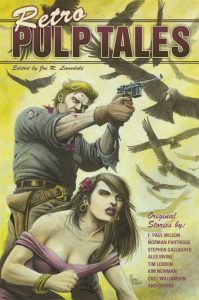 It was inevitable that Joe would dive into the pulps, a goldmine of storytelling. “A lot of the books that I read were related to the pulps. When I read Edgar Rice Burroughs or Robert E. Howard, those stories had all been published in the pulps. So, I was heavily influenced by the pulps. I think it was the color, the movement, and the purely active storytelling.”
It was inevitable that Joe would dive into the pulps, a goldmine of storytelling. “A lot of the books that I read were related to the pulps. When I read Edgar Rice Burroughs or Robert E. Howard, those stories had all been published in the pulps. So, I was heavily influenced by the pulps. I think it was the color, the movement, and the purely active storytelling.”
Lansdale noted the significant names that emerged from the rough paper trade. “There were certainly great writers who came out of the pulps. Ray Bradbury, Tennessee Williams, and MacKinlay Kantor came out of them. I mean there are just tons of people who wrote for the pulps. And a lot of people don’t know that Hemingway tried to write for the pulps and failed. I think even one or two of those stories still exist.”
Lansdale admits the pulp influence remains in his writing. “When I read Hemingway, F. Scott Fitzgerald, Steinback, and later Flannery O’Connor and Faulkner … it all blended with me … that pure appeal of the pulps and genre fiction … with the well-developed characterization of literary works. I think the two are a marvelous match. When I write, I can dip into any well I need because they’re all part of me.”
He believes that he’s not alone. “I think that in the last few years, you’re starting to see that a lot of novelists and a lot of short story writers who didn’t actually grow up on the pulps … have started using their elements. A lot of literary writers have used crime and science fiction and fantasy to tell their stories.”
When asked about one of the themes of PulpFest 2021, Lansdale had a lot to say.
“I am reasonably certain that when I was a child, I heard some Shadow episodes on the radio. I was born in 1951 and I think they tottered on into the early sixties. I know I was young and my memories are vague, but when I later listened to the radio shows, I had this odd feeling of déjà vu for the character and his catch phrase, ‘The Shadow Knows.’ But my first real exposure was the old pulp novels reprinted in paperback. I liked The Shadow and Doc Savage, but I never managed to read them all.”
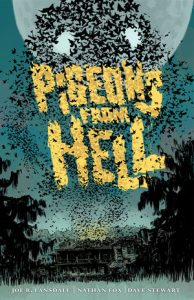 Always honest, he admits his allegiance to one of The Shadow’s fictional offspring. “Batman was my main man, and I’m sure elements of him must have come from The Shadow. I also remember seeing THE BAT on television, based on the Mary Rinehart novel. There were elements of The Shadow there, and I think Bob Kane said the film influenced his creation of Batman. But I think The Shadow had a lot of influence.”
Always honest, he admits his allegiance to one of The Shadow’s fictional offspring. “Batman was my main man, and I’m sure elements of him must have come from The Shadow. I also remember seeing THE BAT on television, based on the Mary Rinehart novel. There were elements of The Shadow there, and I think Bob Kane said the film influenced his creation of Batman. But I think The Shadow had a lot of influence.”
Lansdale also admits to another preference, one that may spark some controversy with fans of The Shadow. “When I grew older, I came to think Doc Savage was written better. But I loved the creepy mystery of The Shadow, saw some of the old films or serials. Don’t remember when or where, but they stuck with me. Like Philip José Farmer, one of my heroes, I have always been fascinated with all the great pulp characters and how they might fit into modern sensibilities.”
Another of Joe Lansdale’s favorites was Edgar Rice Burrough’s Tarzan. In the 1990’s he was asked to finish an incomplete ERB Tarzan novel. It eventually became TARZAN: THE LOST ADVENTURE, published in 1995 as four pulp magazine format books by Dark Horse Comics. The series was later collected into one volume.
Asked what it was like to add to such a legendary author’s canon, Lansdale was both humble and protective. “It was an honor. Much can be made of those books being racist and sexist, and they would be right. But their impact reaches far beyond their failings. He was a writer of his time, and though that doesn’t excuse racism, etc., it explains it. As a kid, it was the magic of Burroughs’ storytelling that hooked me. A handful of the stories — Tarzan, John Carter, Pellucidar, and others — hold up in that department.”
As much as he loves the author, Lansdale acknowledges Burroughs had flaws. “Though most have terrific openings and endings and conventional middles, ERB seemed to think that if it was good last time it would be good again. A lot of the later books lost that dreamlike magic the early ones had. But man, when he was on, he was on!”
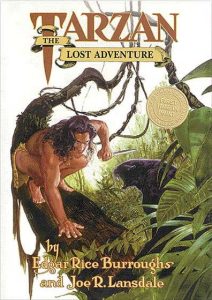 He’s also firm in his belief that Burroughs’ works shouldn’t be updated. “Perhaps their failings should be noted in new introductions,” he suggested. “But like some old films, they shouldn’t be dismissed for those elements. Readers can make their own choices about the books within that context.”
He’s also firm in his belief that Burroughs’ works shouldn’t be updated. “Perhaps their failings should be noted in new introductions,” he suggested. “But like some old films, they shouldn’t be dismissed for those elements. Readers can make their own choices about the books within that context.”
Lansdale did address such issues when he had the chance. “When I wrote TARZAN: THE LOST ADVENTURE, based on the pages Burroughs had written, I tried to eliminate that aspect as much as possible and be true to what he had written otherwise. I moved pieces around, eliminated repetitive elements. It seemed in memory that he killed a big cat every chapter, though I doubt it was that bad. But it was great to take what he had started and finish it, trying to bring it into a more modern context with a blend of his style and mine.”
He noted that finishing the work of another author was a challenge. “It would be easier to write an original, but the honor of it was overwhelming. Problem was, it wasn’t his best work by far. I think there was a reason it had been in a trunk for fifty years.”
Still, Lansdale would dive in again. “I’d love to write a sequel to the book, which ends with Tarzan on his way to Pellucidar, the center of the earth. Of course, he had been there before in TARZAN AT THE EARTH’S CORE.”
He continued: “I was just as excited to have the opportunity to write a Tarzan story and a John Carter story for two different anthologies.” The John Carter short story was “The Metal Men of Mars” in the anthology UNDER THE MOONS OF MARS, edited by John Joseph Adams and published by Simon & Schuster in 2012.
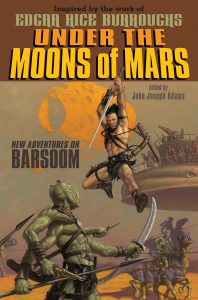 What’s next for the Champion Mojo storyteller? “MOON LAKE comes out this summer, which is a mysterious, Southern Gothic crime novel that takes place in the sixties and seventies,” Lansdale said. “After that, RADIANT APPLES, which is a Nat Love adventure at the end of the Old West era, during the time he has begun to work for the railroad as a porter. Nat Love was a real black cowboy, but I’ve written a novel (PARADISE SKY, 2015, published by Mulholland Books) and some stories based on a fictional Nat Love.”
What’s next for the Champion Mojo storyteller? “MOON LAKE comes out this summer, which is a mysterious, Southern Gothic crime novel that takes place in the sixties and seventies,” Lansdale said. “After that, RADIANT APPLES, which is a Nat Love adventure at the end of the Old West era, during the time he has begun to work for the railroad as a porter. Nat Love was a real black cowboy, but I’ve written a novel (PARADISE SKY, 2015, published by Mulholland Books) and some stories based on a fictional Nat Love.”
Whatever he writes, we’ll certainly be anticipating the next work by this storyteller in love with stories.
To learn more about Joe R. Lansdale and his work, please visit www.joerlansdale.com. His latest collection, FISHING FOR DINOSAURS, was published in November 2020 by Subterranean Press, with jacket art by Timothy Truman. Subterranean was also the publisher of the Lansdale-edited anthology RETRO PULP TALES in 2006. Also featuring jacket art by Truman, it shared the Bram Stoker Award for Best Anthology.
A wide-ranging writer, the champion mojo storyteller has also scripted films, television shows, cartoons, comics, and graphic novels. In addition to Edgar Rice Burroughs, WEIRD TALES great Robert E. Howard was also a favorite of Lansdale. In 2008, the author adapted Howard’s Southern Gothic horror classic “Pigeons from Hell” for artist Nathan Fox. The four-issue miniseries was published by Dark Horse Comics. It was reissued in the trade paperback format in 2009. Howard’s story originally ran in the May 1938 WEIRD TALES.
Dark Horse Comics also published Lansdale’s completion of an Edgar Rice Burroughs manuscript as a four-issue serial in 1995. It was reissued in hardcover in 1996, featuring jacket art by Dean Williams. In addition to this Tarzan novel, Lansdale has also written Burroughs-inspired stories for various anthologies. His tale, “The Metal Men of Mars,” was the lead story in John Joseph Adams’ UNDER THE MOONS OF MARS. This anthology — published in 2012 by Simon & Schuster — featured jacket art by Mark Zuk.
Christopher Ryan has been an award-winning journalist, teacher, podcaster, actor, producer, and director, but mostly he writes fast-paced stories with humor and heart. You can learn more about Christopher and his work at www.chrisryanwrites.
With his longtime friend, writer Alex Simmons, Christopher is the host of the TELL THE DAMN STORY podcast. They talk about books, comics, film, conventions, and other creative arts and pop culture topics on the show. You can tune in on Apple Podcasts, Pocket Cast, Spotify, and other platforms.

